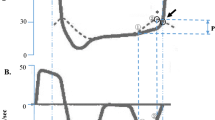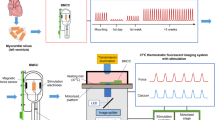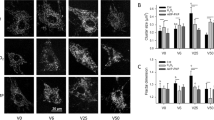Abstract
Stretching of cardiac muscle modulates contraction through the enhancement of the Ca2+ transient, but how this occurs is still not known. We found that stretching of myocytes modulates the elementary Ca2+ release process from ryanodine-receptor Ca2+-release channels (RyRCs), Ca2+ sparks and the electrically stimulated Ca2+ transient. Stretching induces PtdIns-3-OH kinase (PI(3)K)-dependent phosphorylation of both Akt and the endothelial isoform of nitric oxide synthase (NOS), nitric oxide (NO) production, and a proportionate increase in Ca2+-spark frequency that is abolished by inhibiting NOS and PI(3)K. Exogenously generated NO reversibly increases Ca2+-spark frequency without cell stretching. We propose that myocyte NO produced by activation of the PI(3)K–Akt–endothelial NOS axis acts as a second messenger of stretch by enhancing RyRC activity, contributing to myocardial contractile activation.
This is a preview of subscription content, access via your institution
Access options
Subscribe to this journal
Receive 12 print issues and online access
$209.00 per year
only $17.42 per issue
Buy this article
- Purchase on Springer Link
- Instant access to full article PDF
Prices may be subject to local taxes which are calculated during checkout




Similar content being viewed by others
References
Lakatta, E. G. Cardiovascular regulatory mechanisms in advanced age. Physiol. Rev. 73, 413–467 (1993).
Allen, D. G. & Kurihara, S. The effects of muscle length on intracellular calcium transients in mammalian cardiac muscle. J. Physiol. (Lond.) 327, 79–94 (1982).
Hongo, K., White, E., Le Guennec, J. Y. & Orchard, C. H. Changes in [Ca2+]i, [Na+]i and Ca2+ current in isolated rat ventricular myocytes following an increase in cell length. J. Physiol. (Lond.) 491, 609–619 (1996).
Parmley, W. W. & Chuck, L. Length-dependent changes in myocardial contractile state. Am. J. Physiol. 224, 1195–1199 (1973).
Pinsky, D. J. et al. Mechanical transduction of nitric oxide synthesis in the beating heart. Circ. Res. 81, 372–379 (1997).
Feron, O. et al. Endothelial nitric oxide synthase targeting to caveolae: specific interactions with caveolin isoforms in cardiac myocytes and endothelial cells. J. Biol. Chem. 271, 22810–22814 (1996).
Levin, K. R. & Page, E. Quantitative studies on plasmalemmal folds and caveolae of rabbit ventricular myocardial cells. Circ. Res. 46, 244–255 (1980).
Doyle, D. D. et al. Dystrophin associates with caveolae of rat cardiac myocytes: relationship to dystroglycan. Circ. Res. 87, 480–488 (2000).
Xu, L., Eu, J. P., Meissner, G. & Stamler J. S. Activation of the cardiac calcium release channel (ryanodine receptor) by poly-S-nitrosylation. Science 279, 234–237 (1998).
Stoyanovsky, D., Murphy, T., Anno, P. R., Kim, Y. M. & Salama, G. Nitric oxide activates skeletal and cardiac ryanodine receptors. Cell Calcium 21, 19–29 (1997).
Eu, J. P., Sun, J., Xu, L., Stamler, J. S. & Meissner G. The skeletal muscle calcium release channel: coupled O2 sensor and NO signalling functions. Cell 102, 499–509 (2000).
Hess, D. T., Matsumoto, A., Nudelman, R. & Stamler, J. S. S-nitrosylation: spectrum and specificity. Nature Cell Biol. 3, E46–E49 (2001).
Sollott, S. J. & Lakatta, E. G. Novel method to alter length and load in isolated mammalian cardiac myocytes. Am. J. Physiol. 267, H1619–H1629 (1994).
Cheng, H., Lederer, W. J. & Cannell, M. B. Calcium sparks: elementary events underlying excitation–contraction coupling in heart muscle. Science 262, 740–744 (1993).
Cheng, H. et al. Amplitude distribution of calcium sparks in confocal images: theory and studies with an automatic detection method. Biophys. J. 76, 606–617 (1999).
Zorov, D. B., Filburn, C. R., Klotz, L.-O., Zweier, J. L. & Sollott, S. J. Reactive oxygen species (ROS)-induced ROS release: a new phenomenon accompanying induction of the mitochondrial permeability transition in cardiac myocytes. J. Exp. Med. 192, 1001–1014 (2000).
Willmott, N. J., Wong, K. & Strong, A. J. A fundamental role for the nitric oxide-G-kinase signalling pathway in mediating intercellular Ca2+ waves in glia. J. Neurosci. 20, 1767–1779 (2000).
Kojima, H. et al. Detection and imaging of nitric oxide with novel fluorescent indicators: diaminofluoresceins. Anal. Chem. 70, 2446–2453 (1998).
Wilson, H. L. & Galione, A. Differential regulation of nicotinic acid-adenine dinucleotide phosphate and cADP-ribose production by cAMP and cGMP. Biochem. J. 331, 837–843 (1998).
Satoh, H., Blatter, L. A. & Bers, D. M. Effects of [Ca2+]i, SR Ca2+ load, and rest on Ca2+ spark frequency in ventricular myocytes. Am. J. Physiol. 272, H657–H668 (1997).
Han, S., Schiefer, A. & Isenberg, G. Ca2+ load of guinea-pig ventricular myocytes determines efficacy of brief Ca2+ currents as trigger for Ca2+ release. J. Physiol. (Lond.) 480, 411–421 (1994).
Bassani, J. W., Yuan, W. & Bers, D. M. Fractional SR Ca release is regulated by trigger Ca and SR Ca content in cardiac myocytes. Am. J. Physiol. 268, C1313–C1319 (1995).
Bers, D. M., Bridge, J. H. & Spitzer, K. W. Intracellular Ca2+ transients during rapid cooling contractures in guinea-pig ventricular myocytes. J. Physiol. (Lond.) 417, 537–553 (1989).
Perez, N. G., Camilion de Hurtado, M. C. & Cingolani, H. E. Reverse mode of the Na+-Ca2+ exchange after myocardial stretch: underlying mechanism of the slow force response. Circ. Res. 88, 376–382 (2001).
Fulton, D. et al. Regulation of endothelium-derived nitric oxide production by the protein kinase Akt. Nature 399, 597–601 (1999).
Dimmeler, S. et al. Activation of nitric oxide synthase in endothelial cells by Akt-dependent phosphorylation. Nature 399, 601–605 (1999).
Chen, Y., Simasko, S. M., Niggel, J., Sigurdson, W. J. & Sachs, F. Ca2+ uptake in GH3 cells during hypotonic swelling: the sensory role of stretch-activated ion channels. Am. J. Physiol. 270, C1790–C1798 (1996).
Vila-Petroff, M. G., Younes, A., Egan, J., Lakatta, E. G. & Sollott, S. J. Activation of distinct cAMP-dependent and cGMP-dependent pathways by nitric oxide in cardiac myocytes. Circ. Res. 84, 1020–1031 (1999).
Balligand, J. L., Kelly, R. A., Marsden, P. A., Smith, T. W. & Michel, T. Control of cardiac muscle cell function by an endogenous nitric oxide signalling system. Proc. Natl Acad. Sci. USA 90, 347–351 (1993).
Prendergast, B. D., Sagach, V. F. & Shah, A. M. Basal release of nitric oxide augments the Frank–Starling response in the isolated heart. Circulation 96, 1320–1329 (1997).
Balligand, J. L., Feron, O. & Kelly, R. A. in Nitric Oxide: Biology and Pathobiology (ed. Ignarro, L.) 585–607 (Academic, San Diego, 2000).
Shah, A. M. & MacCarthy, P. A. Paracrine and autocrine effects of nitric oxide on myocardial function. Pharmacol. Ther. 86, 49–86 (2000).
Alvarez, B. V., Perez, N. G., Ennis, I. L., Camilion de Hurtado, M. C. & Cingolani, H. E. Mechanisms underlying the increase in force and Ca2+ transient that follow stretch of cardiac muscle: a possible explanation of the Anrep effect. Circ. Res. 85, 716–722 (1999).
Kentish, J. C. A role for the sarcolemmal Na+/H+ exchanger in the slow force response to myocardial stretch. Circ. Res. 85, 658–660 (1999).
Yamazaki, T. et al. Endothelin-1 is involved in mechanical stress-induced cardiomyocyte hypertrophy. J. Biol. Chem. 271, 3221–3228 (1996).
Sadoshima, J., Xu, Y., Slayter, H. S. & Izumo, S. Autocrine release of angiotensin II mediates stretch-induced hypertrophy of cardiac myocytes in vitro. Cell 75, 977–984 (1993).
Yamazaki, T. et al. Role of ion channels and exchangers in mechanical stretch-induced cardiomyocyte hypertrophy. Circ. Res. 82, 430–437 (1998).
Saward, L. & Zahradka, P. Angiotensin II activates phosphatidylinositol 3-kinase in vascular smooth muscle cells. Circ. Res. 81, 249–257 (1997).
Takahashi, T. et al. Activation of Akt/protein kinase B after stimulation with angiotensin II in vascular smooth muscle cells. Am. J. Physiol. 276, H1927–H1934 (1999).
Haendeler, J., Ishida, M., Hunyady, L. & Berk, B. C. The third cytoplasmic loop of the angiotensin II type 1 receptor exerts differential effects on extracellular signal-regulated kinase (ERK1/ERK2) and apoptosis via Ras- and Rap1-dependent pathways. Circ. Res. 86, 729–736 (2000).
Clerk, A. & Sugden, P. H. Activation of protein kinase cascades in the heart by hypertrophic G protein-coupled receptor agonists. Am. J. Cardiol. 83, 64H–69H (1999).
Naga Prasad, S. V., Esposito, G., Mao, L., Koch, W. J. & Rockman, H. A. G-dependent phosphoinositide 3-kinase activation in hearts with in vivo pressure overload hypertrophy. J. Biol. Chem. 275, 4693–4698 (2000).
Calderone, A., Thaik, C. M., Takahashi, N., Chang, D. L. & Colucci, W. S. Nitric oxide, atrial natriuretic peptide, and cyclic GMP inhibit the growth-promoting effects of norepinephrine in cardiac myocytes and fibroblasts. J. Clin. Invest. 101, 812–818 (1998).
Marte, B. M. & Downward, J. PKB/Akt: connecting phosphoinositide 3-kinase to cell survival and beyond. Trends Biochem. Sci. 22, 355–358 (1997).
Fujio, Y., Nguyen, T., Wencker, D., Kitsis, R. N. & Walsh, K. Akt promotes survival of cardiomyocytes in vitro and protects against ischemia-reperfusion injury in mouse heart. Circulation 101, 660–667 (2000).
Rossig, L. et al. Nitric oxide inhibits caspase-3 by S-nitrosation in vivo. J. Biol. Chem. 274, 6823–6826 (1999).
Mannick, J. B. et al. Fas-induced caspase denitrosylation. Science 284, 651–654 (1999).
Gomez, A. M. et al. Defective excitation–contraction coupling in experimental cardiac hypertrophy and heart failure. Science 276, 800–806 (1997).
Moniotte, S. et al. Upregulation of β3-adrenoceptors and altered contractile response to inotropic amines in human failing myocardium. Circulation 103, 1649–1655 (2001).
Acknowledgements
We thank E.G. Lakatta and H. Cheng for useful discussions, M.D. Stern for critical comments on the manuscript, and M. Juhaszova, H.A. Spurgeon, K. Tarasov and B.D. Ziman for technical support. This work was supported by the Intramural Research Program, National Institute on Aging (S.J.S.), and an Action de Recherche Concertée (French Community of Belgium) and the National Fund for Scientific Research (J.L.B.).
Author information
Authors and Affiliations
Corresponding author
Supplementary information
Supplementary information
Analysis of membrane distribution of caveolae and estimation of the spatial range of NO action (PDF 125 kb)
Rights and permissions
About this article
Cite this article
Petroff, M., Kim, S., Pepe, S. et al. Endogenous nitric oxide mechanisms mediate the stretch dependence of Ca2+ release in cardiomyocytes. Nat Cell Biol 3, 867–873 (2001). https://doi.org/10.1038/ncb1001-867
Received:
Revised:
Accepted:
Published:
Issue Date:
DOI: https://doi.org/10.1038/ncb1001-867
This article is cited by
-
Identification of RNA reads encoding different channels in isolated rat ventricular myocytes and the effect of cell stretching on L-type Ca2+current
Biology Direct (2023)
-
Towards precision medicine in heart failure
Nature Reviews Cardiology (2021)
-
Stretch modulation of cardiac contractility: importance of myocyte calcium during the slow force response
Biophysical Reviews (2020)
-
Nitric oxide signalling in cardiovascular health and disease
Nature Reviews Cardiology (2018)
-
Regional increase in ROS within stretched region exacerbates arrhythmias in rat trabeculae with nonuniform contraction
Pflügers Archiv - European Journal of Physiology (2018)



